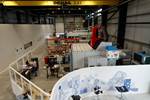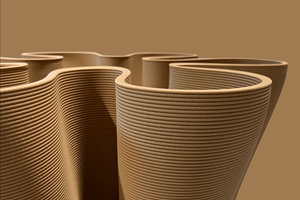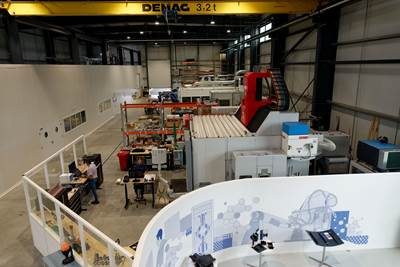AFRL pushes limits of polymer additive manufacturing
Air Force Research Laboratory research team has successfully printed the highest-temperature capable, reinforced polymer composite parts.
Share
Read Next
Researchers at the Air Force Research Laboratory’s Materials and Manufacturing Directorate (, OH, US) are “turning up the heat” in the field of polymer additive manufacturing.
In conjunction with researchers at NASA’s Glenn Research Center (Cleveland, OH, US) and the University of Louisville (Louisville, KY, US), the team successfully printed the highest-temperature capable, reinforced polymer composite parts using additive manufacturing. Consisting of a high temperature thermoset resin infused with carbon fiber filaments, this state-of-the art material breakthrough sets the stage for next generation, cost-efficient Air Force manufacturing needs.
“This is an extremely impactful breakthrough in composite material additive manufacturing,” says Dr. Hilmar Koerner, a scientist on the Polymer Matrix Composite Materials and Processing Research Team and the driving force behind the novel discovery. “These 3D printed parts can withstand temperatures greater than 300° Celsius, making them potentially useful for turbine engine replacement parts or in hot areas around engine exhaust.”
Polymer matrix composites are extremely attractive to Air Force researchers working on next-generation applications due to their light-weight properties and ability to withstand extreme conditions in high temperature environments. This plays an important role in increasing aircraft range while reducing fuel consumption, both of which are key to reducing operating costs over the long term.
Typically, polymer composites consist of a fiber, such as glass, embedded in a matrix or resin made of epoxy or other material. The embedded fibers reinforce the matrix, making the resulting material stronger.
During a polymer additive manufacturing technique called laser sintering, a high temperature laser is run across a bed of polymer powder to form a pre-designed, computer generated shape. This process is repeated multiple times with new layers of powder and laser energy until a 3D part is complete.
While experimenting with high temperature polymer resins, Koerner and his team found that the polymers printed well, but when they removed the pieces from the powder bed for post-processing, the material would essentially “melt into puddles,” proving useless.
To counteract this issue and better enable molecules to entangle and form a shape under the heat of the laser, Koerner suggested adding carbon fiber filler to the resin material as a means of enabling better energy transfer from the laser to the matrix. The carbon fiber would cause the laser to heat the material much faster by absorbing the laser energy and conducting heat much faster than with the polymer alone.
As a result, the researchers successfully printed high temperature polymer composite sample pieces in multiple configurations, in what, to their knowledge, are the highest temperature capable, polymer composite parts made by additive manufacturing to this day.
“High temperature materials are notoriously hard and expensive to process, even using conventional manufacturing techniques,” says Dr. Jeffery Baur, a principal materials engineer at AFRL. “Since they typically wind up being used in military specific applications, there is not a large supplier base for these types of materials. This breakthrough will enable us to additively manufacture high temperature, composite parts in a cost-efficient manner. Moreover, high temperature polymer composite parts that are small and have complex features will be extremely beneficial and advantageous not only for the Air Force, but have the potential to be a game-changer throughout industry.”
The team successfully printed a number of test coupons and brackets with the novel material and plan to demonstrate the ability to print larger parts as the next step in their process. Preliminary test data indicates that the material can withstand elevated temperatures, but further testing and qualification of the material is needed prior to implementation on Air Force platforms.
Nevertheless, this is a significant breakthrough in additive manufacturing with huge, cost saving benefits for the Air Force over the long term.
“This is a high, value-added capability for the Air Force,” says Baur. “We are excited about this breakthrough and look forward to seeing the impacts over the future.”
Related Content
Sulapac introduces Sulapac Flow 1.7 to replace PLA, ABS and PP in FDM, FGF
Available as filament and granules for extrusion, new wood composite matches properties yet is compostable, eliminates microplastics and reduces carbon footprint.
Read MoreHitachi Rail chooses Roboze printers, materials including carbon fiber/PEEK for railway spare parts
The Roboze ARGO 500 will be used at Hitachi Rail factories in Naples, Italy and Maryland, U.S. to reduce cost and delivery times for prototypes and spare parts.
Read MoreLarge-format AM speeds plug production for manufacture of composite boat molds
Hungarian manufacturer Rapid Prototyping transitioned its conventional foam milling process to 3D printing to produce faster, higher quality, recyclable foam plugs and composite boat molds.
Read MoreOrbital Composites wins AFWERX award for Starfighter drone fleet
Under the TACFI contract, Orbital is implementing the AMCM process to build 3D printed composite multi-mission UAS aircraft, surpassing $10 million in government awards.
Read MoreRead Next
Plant tour: Daher Shap’in TechCenter and composites production plant, Saint-Aignan-de-Grandlieu, France
Co-located R&D and production advance OOA thermosets, thermoplastics, welding, recycling and digital technologies for faster processing and certification of lighter, more sustainable composites.
Read MoreAll-recycled, needle-punched nonwoven CFRP slashes carbon footprint of Formula 2 seat
Dallara and Tenowo collaborate to produce a race-ready Formula 2 seat using recycled carbon fiber, reducing CO2 emissions by 97.5% compared to virgin materials.
Read MoreAssembling the Multifunctional Fuselage Demonstrator: The final welds
Building the all-thermoplastic composite fuselage demonstrator comes to an end with continuous ultrasonic welding of the RH longitudinal fuselage joint and resistance welding for coupling of the fuselage frames across the upper and lower halves.
Read More












